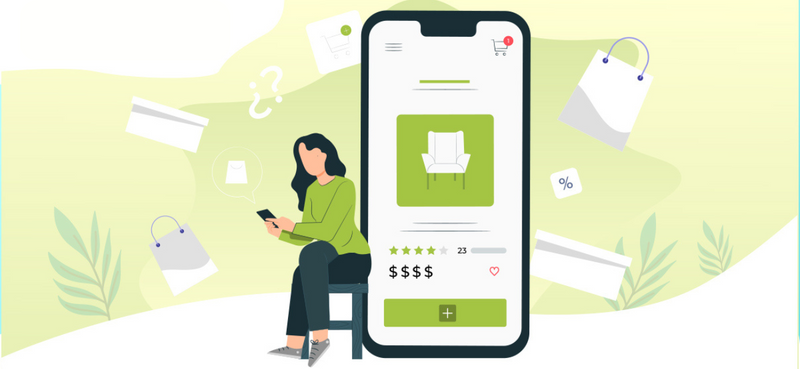
Why is Shopify so popular?
Shopify has been around for a long time, it was one of the first complete online store builders and offered a seamless way for both physical and online businesses to scale their operations. Today, practically everyone thinks of Shopify whenever they hear the word E-commerce.
However, they have been prone to letting their winning position slip and recently there has been an advent of Shopify competitors that have come to the fold. Let’s take a look at the best Shopify alternatives out there and see which of them gives you the best chance to succeed in e-commerce.
Before we do that, let’s just get a quick overview of what Shopify offers today.
Best features of Shopify
- Fast converting checkout with Shopify payment.
- A large number of dedicated Apps and third-party support.
- Adaptable themes that are mobile-friendly.
- Mobile app with support for Point of Sale (POS).
- Easy to use for non-developers.
- Builtin marketing automation tools to support omnichannel marketing without the need for external apps.
- An ecosystem of Shopify professionals that can help you build a customized website.
Weak points of Shopify
- Only offers a 3-day trial period compared to the industry standard of 7 or 14 days.
- Expensive, has high subscription costs and charges transaction fees.
- Known for not having the fastest and most effective support team, people rely more on the Shopify community.
- Offers a more limited experience out of the box but does let you build with many Addons and third-party apps, however, this only raises the cost.
- Lacks localized integrations for Payment and Shipping options and pushes users to use Shopify payments.
Alternative Platforms to Shopify
1. Jumpseller
The best overall Shopify alternative is Jumpseller. A modern e-commerce platform, similar to Shopify in my ways, but better in terms of value for money and comes with more features out of the box. Jumpseller also offers a hosted solution. Let’s look at the comparison in detail.
Compare Jumpseller to Shopify
Strong Points:
- No Transaction Fees per sale and all plans are relatively inexpensive.
- Localized Payment and Shipping Options.
- Personalized and faster support.
- Easy to scale business with in-built advanced features without the need for third-party apps.
- Offers phone support, when you create a store with Jumpseller you have the option to set up a call with an expert to help guide you through setting up your store.
Weak Points:
- Compared to Shopify, Jumpseller offers limited apps, so most third-party apps require integration before they can be used.
- The Jumpseller Mobile App is not as robust, it also has a weaker POS system that comes with the app.
- Marketing automation tools are something where Shopify takes the cake, although Jumpseller is starting to catch up on that front but there is a long way to go yet.
Pricing
This is where Jumpseller is far superior to Shopify, Aside from having a lower base subscription fee, there are no Transaction Fees with Jumpseller. On top of that, Jumpseller Apps don’t cost you an arm and a leg, making it affordable to scale your business by adding more features on top of the base ones.
Start your free 7-day trial. No credit card required.
2. Wix
Another hosted e-commerce platform, that is popular for its drag-and-drop customisation on themes. Wix offers a simpler way to get started with your website, Build it with AI! You can answer a series of questions to an AI chatbot that will then create a customised website for you. Once the website has been made you can build on top of it.
Compare Wix to Shopify
Strong Points:
- Wix is easier to use with amazing drag-and-drop interfaces for beginners, making it a go-to for users with little technical knowledge.
- With Wix ADI, you can automatically create a website based on a few questions about their preferences.
- It’s generally cheaper than Shopify, especially for small businesses looking for basic e-commerce features.
Weak Points:
- On Wix, it is harder to switch between templates, Once a template is selected and published, switching templates requires significant manual changes.
- While Wix offers easier customization from the off, it lacks in-app add-ons. Making advanced customization challenging, unlike Shopify which offers a large marketplace of apps and plugins to enhance store functionality, making customization easier without needing to code.
- While Wix offers good integrations with marketing platforms, Shopify has better marketing tools, offering email marketing, and direct integrations with platforms like Facebook, Google Ads, and TikTok.
Pricing
Wix is less expensive than Shopify and does not charge a per-sale fee. It offers 4 main plans, Light, Core, Business and Business Elite. Light is the plan with the lowest price, starting at 12 USD. However, that plan is extremely restricted with only 2GB of Storage space and close to no additional e-commerce functionality.
3. WooCommerce
WooCommerce is an open-source solution built on WordPress, offering flexibility and customization. It’s a popular choice for entrepreneurs, freelancers, and small business owners who already have WordPress websites and want to add e-commerce functionality.
Compare WooCommere to Shopify
Strong Points:
- More flexibility when it comes to customization. WooCommerce’s open-source nature allows developers to build tailored stores.
- Being part of WordPress, WooCommerce benefits from a huge global community, with countless tutorials, forums, and documentation to help troubleshoot issues.
- Full control over SEO allowing you the opportunity to rank better. Shopify also has good built-in SEO features with limited customization possible.
- Has the best inbuilt blogging functionality.
- Gives access to more themes from the WordPress universe and has more Free themes available.
Weak Points:
- Because WooCommerce comes with few features found on other platforms, the costs of installing and using external apps build up over time.
- WooCommerce is more geared towards professional website creators with more technical knowledge. Shopify gets the vote for being more user-friendly.
- Unlike Shopify, WooCommerce is not a hosted solution. Meaning you will incur additional costs that are not always fixed.
- Performance and page speed depend a lot on the hosting provider and site configuration.
- Scalability can be a challenge since you depend on an external hosting provider, Shopify provides a more stable platform for growth.
Pricing
WooCommerce is Free to start, however, the price does get more unpredictable as every addon and third-party app piles up the costs. And there are times when you will need quite a few of them installed. In contrast, Shopify has a more predictable pricing model based on the plan selected.
4. Squarespace
Considered the epitome of web design for online businesses, Squarespace is another platform that is often mentioned when talking about Shopify, however they both target different types of users. Shopify is more focused on e-commerce whereas Squarespace caters to creative professionals like designers, artists, agencies, etc.
Compare Squarespace to Shopify
Strong Points:
- The design systems of Squarespace are extremely intuitive and ideal for beginners or users with little to no coding knowledge.
- Highly customizable through its drag-and-drop editor. It is ideal for artists, designers, and businesses that prioritize aesthetics.
- It’s great for selling digital products, services, and subscriptions without the need for extensive customization.
Weak Points:
- While Squarespace supports e-commerce, it’s not as specialized or robust as Shopify, which is designed exclusively for online selling.
- Shopify allows integration with a wide range of sales channels like Amazon, eBay, Etsy, and various social media platforms (Facebook, Instagram, TikTok), whereas Squarespace’s integrations are more limited.
- Squarespace gatekeeps certain features for higher-tier plans only, such as abandoned cart recovery, while Shopify offers this feature on all plans starting from the Basic tier.
- Squarespace’s app selection is far more limited, restricting customization and scalability for growing businesses.
Pricing
Squarespace has clear pricing tiers with no additional transaction fees, making it easier for small businesses to predict costs. The plans start lower than Shopify’s, making it more budget-friendly for general website needs.
Final thoughts
Honestly, today there is a plethora of e-commerce tools out there, so by pinning your e-commerce vision on Shopify you may be missing out on better alternatives. Ideally, you should start by analyzing your business requirements and try to match them with the strengths of each of the platforms we’ve covered today. And if you are already selling with a specific platform, don’t worry, you can easily migrate your website to another platform without having to build it from zero.






